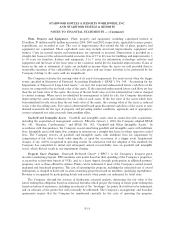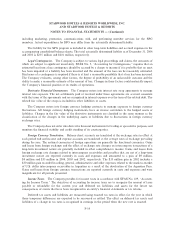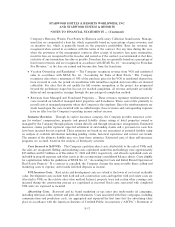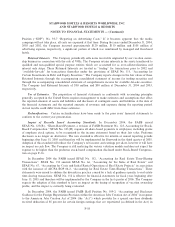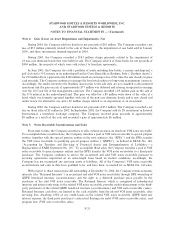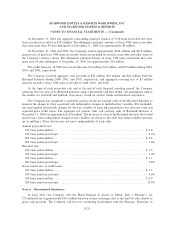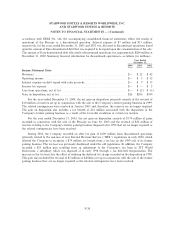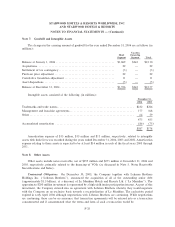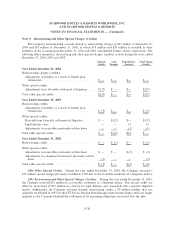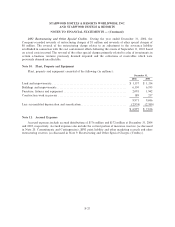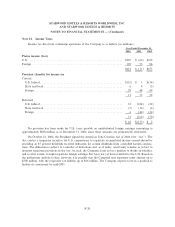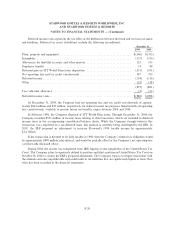Starwood 2004 Annual Report Download - page 85
Download and view the complete annual report
Please find page 85 of the 2004 Starwood annual report below. You can navigate through the pages in the report by either clicking on the pages listed below, or by using the keyword search tool below to find specific information within the annual report.STARWOOD HOTELS & RESORTS WORLDWIDE, INC.
AND STARWOOD HOTELS & RESORTS
NOTES TO FINANCIAL STATEMENTS Ì (Continued)
either an enterprise's last tax year that began before the December 2004 enactment date, or the Ñrst tax year
that begins during the one-year period beginning on the date of enactment. Starwood is reviewing the Act in
order to determine if funds can be repatriated.
In November 2004, the Emerging Issues Task Force (""EITF'') issued EITF No. 04-8, ""The EÅect of
Contingently Convertible Debt on Diluted Earnings Per Share'' which states that contingently convertible
debt instruments are subject to the if-converted method under FASB Statement No. 128 regardless of the
contingent features included in the instrument. As the terms of the contingently convertible debt instrument
allow for the Company to redeem such instruments in cash and the Company has a history of settling
convertible debt instruments in cash, the Company, in accordance with SFAS No. 128, has utilized the
if-converted method if certain trigger events are met. Accordingly, EITF No. 04-08 did not have an impact to
the Company's net income or earnings per share.
In December 2003, FASB issued SFAS No. 132 (revised 2003), ""Employers' Disclosures about
Pensions and Other Postretirement BeneÑts'' (SFAS No. 132(R)). SFAS No. 132(R) retains the disclosure
requirements in the original SFAS No. 132, but requires additional disclosures related to plan assets, plan
obligations, cash Öows and net periodic beneÑt cost of deÑned beneÑt pension and other postretirement plans.
In addition, this statement requires interim period disclosure of the components of net periodic beneÑt costs
and contributions if signiÑcantly diÅerent from previously reported amounts. In accordance with the transition
rules, the Company adopted SFAS No. 132(R) eÅective December 31, 2003 for its domestic pension and
postretirement plans and eÅective December 31, 2004 for the Company's foreign pension plans, and
incorporated the new disclosure requirements into Note 14. Employee BeneÑt Plans.
In May 2003, FASB issued SFAS No. 150, ""Accounting for Certain Financial Instruments with
Characteristics of both Liabilities and Equity.'' This statement establishes standards for how an issuer
classiÑes and measures certain Ñnancial instruments with characteristics of both liabilities and equity, and is
eÅective for Ñnancial instruments entered into or modiÑed after May 31, 2003, and otherwise is eÅective at the
beginning of the Ñrst interim period beginning after June 15, 2003. As a result of further discussion by the
FASB on October 8, 2003, the FASB announced that minority interests in consolidated partnerships with
speciÑed Ñnite lives should be reclassiÑed as liabilities and presented at fair market value unless the interests
are convertible into the equity of the parent. Fair market value adjustments occurring subsequent to July 1,
2003 should be recorded as a component of interest expense. At their October 29, 2003 meeting, the FASB
agreed to indeÑnitely defer the implementation of their announcement at the October 8, 2003 meeting
regarding the accounting treatment for minority interests in Ñnite life partnerships. Therefore, until a Ñnal
resolution is reached, the Company will not implement this aspect of the standard. If the Company were to
adopt this aspect of the standard under its current provisions, it is not expected to have a material impact on
the Company's Ñnancial statements.
In April 2003, the FASB issued SFAS No. 149, ""Amendment of Statement 133 on Derivative
Instruments and Hedging Activities,'' which amends and clariÑes Ñnancial accounting and reporting for
derivative instruments and hedging activities, including the qualiÑcations for the normal purchases and normal
sales exception, under SFAS No. 133, ""Accounting for Derivative Instruments and Hedging Activities.'' The
amendment reÖects decisions made by the FASB in connection with issues raised about the application of
SFAS No. 133. Generally, the provisions of SFAS No. 149 will be applied prospectively for contracts entered
into or modiÑed after June 30, 2003, and for hedging relationships designated after June 30, 2003. Adoption of
SFAS No. 149 did not have a material eÅect on the Company's Ñnancial statements.
In January 2003, the FASB issued FIN 46 which requires a variable interest entity (""VIE'') to be
consolidated by its primary beneÑciary (""PB''). The PB is the party that absorbs a majority of the VIE's
expected losses and/or receives a majority of the expected residual returns. In December 2003, the FASB
issued FIN 46(R) delaying the eÅective date for certain entities created before February 1, 2003 and making
F-19






